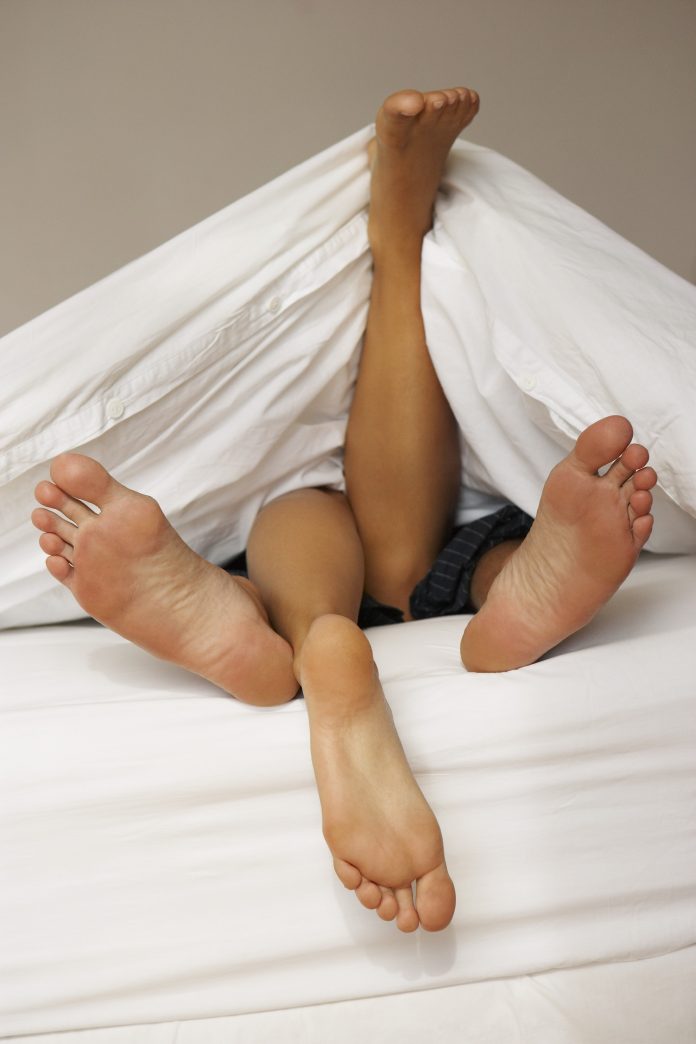Is there a way to naturally treat the most common sexual health ailments? We rounded up the best (and most effective) alternatives to traditional medicines.
By Christopher Habib, ND and Kavita Sabharwal
In the U.S., combined sales of vitamins, supplements, herbs and homeopathic products for intimacy in both the natural and conventional channels grew three per cent year over year. From May 2013 to May 2014, sales for intimate products were at nearly $69 million, up from $67 million for 2012 to 2013, according to data compiled by SPINS. In the mainstream pharmaceutical channel, Viagra alone made over $1 billion in worldwide revenue last year, a number that is gradually decreasing due to increased competition and loss of exclusivity by Pfizer, yet is still widely available.
According to Terrance Morris, Healthy Living Merchandiser at Pomme Natural Market, a method that has been effective for his store has been to group products together by brand rather than condition.
“I have always done this and it works well for us. With my photography and package design background I know companies make their bottles and boxes to give a stronger presence if shelved together as a full unit or section. We have very knowledgeable staff that can help the customer find any item they want,” says Morris.
Sanjiv Jagota, president of Nature’s Source, believes that to build a strong category, the products should accommodate the demand. In his stores, the sexual health category is composed of 60 per cent products related to prostate health. The remaining section is divided into 20 per cent maca, five per cent arginine, seven per cent assorted libido-boosting products, and eight per cent products to encourage urinary tract health.
While you might find it more effective to group products by concern as many retailers often do, Morris believes that may not be the most effective way to promote sales. He finds that with products that are grouped by concern, customers often choose the product that is on sale, rather than based on ingredients or product quality, which is not how he feels a health food store should be.
| Health Conditions | Common Symptoms | Natural Treatment Options | How To Market These Products |
| Benign Prostatic Hyperplasia (BPH) | Men usually experience having to wait for the urine stream to start, poor urinary flow, a variable flow rate, frequent urination, urinary urgency, dribbling, and nocturia. BPH is diagnosed through a digital rectal exam or imaging. | Pygeum bark extract can moderately improve urinary symptoms of prostate inflammation. Numerous human studies show that it reduces urinary hesitancy, frequency, and nocturia. Saw palmetto may also have beneficial effects on prostate health, but there are some conflicting human studies available. These herbs may taken by themselves on an empty stomach. Pairing multiple herbs that have a similar effect (such as these) can be useful in achieving the desired outcome. | To market Pygeum and Saw palmetto, you may want to focus on the method of delivery (for example, if it is a dried herb, capsule form may be easier for some customers). Other customers may prefer a tincture (alcohol extract of the herb). Qualities vary greatly, so suggesting reputable brands with high-quality sourcing is important. You could also focus on products that provide “standardized extracts” on their label. |
| Erectile Dysfunction (ED) | Symptoms include the occasional inability to obtain a full erection, inability to maintain an erection throughout intercourse, or complete inability to achieve an erection. Lack of morning erections can also occur and be associated with a decrease in libido. Patients can be diagnosed with ED after taking a questionnaire from their practitioner. | L-arginine has been studied in randomized controlled trials and has reported benefits in patients in combination with glutamate. L-arginine can help increase nitrate levels and promote vasodilation, helping to improve the symptoms of ED. Consider pairing multiple vasodilators together for an enhanced effect. You could also consider pairing ED treatments with anti-anxiety products, depending on the exact cause of the problem. Other natural options include maca, horny goat weed, tribulus and rhodiola rosea. | When marketing L-arginine, it would be wise to focus on the purity of the product. Companies that have established records of batch testing are more reliable. You may also consider products that combine L-arginine with other vasodilators. The combination products are the ones that showed beneficial effects in research studies, so these may be more effective. |
| Genital Herpes | Herpes sores usually appear as blisters on or around the genitals. The blisters break and leave painful sores that may take weeks to heal. Herpes is sometimes associated with flu-like symptoms such as fever, body aches, or swollen glands. Repeated outbreaks are common, especially during the first year after infection. A practitioner can diagnose genital herpes after a physical exam. | Aloe vera gel is often used topically for dermatological conditions. There is some evidence suggesting that aloe in a cream preparation is an effective treatment for genital herpes in men. Lemon balm (Melissa officinalis) as a topical preparation can help heal sores associated with genital herpes. Finally, sage extracts may be useful in herpes skin infections. Aloe vera is perhaps best used on its own, but sage and lemon balm could be theoretically paired together with other soothing herbs, possibly in a lotion or cream. | Aloe vera gel will normally be sold in tubes. It may help to market products that have no chemicals or preservatives to avoid allergic reactions or sensitivities. Sage and Lemon balm topical preparations can be made from the dried herbs directly, or they can be obtained from commercial preparations. These could be marketed as “natural and soothing herbs.” |
| Low Libido | Low libido can be caused by sexual arousal disorders. In men, it often displays as erectile dysfunction. In women, there is decreased blood flow or lack of vaginal lubrication. Low libido can also be linked to a delay or absence of orgasm following normal sexual excitement. Low libido can be diagnosed with a questionnaire from a practitioner or a hormone panel. | The herb Ginkgo biloba has medicinal properties that increase blood flow. It causes blood vessels to relax and this includes the vessels found in the corpus cavernosum tissue of the penis, and thus can improve penile blood flow. Early studies have suggested that the herbs Panax ginseng, L-arginine, damiana, ginkgo, and multivitamins may improve sexual arousal in women with decreased sex drives. All of these items could be paired together for potential synergistic effects. For immediate relief, women can also use lubricants without propylene glycol which can cause skin irritation or an allergic reaction. | Ginkgo, Panax, and Damiana can all be marketed as stimulant herbs that can boost energy and desire. Marketing could also appeal to boosting sex drive or use slightly more medical terminology such as increased libido. Different products could be made to appeal to men and women differently. Products could also be described as increasing arousal, or increasing natural lubrication. Place a special focus on lubricant products that do not contain propylene glycol and other potentially dangerous chemicals. |
| Fibrocystic Breast Disease | Breast tissue may feel fibrous and lumpy, or may have a texture described as similar to cobblestone. The lumps are usually smooth and have defined edges and are movable. There may also be breast pain felt and it may or may not be related to the menstrual cycle. Nipples may get tender or itchy. Fibrocystic breast disease can be diagnosed with an ultrasound. | There is limited evidence suggesting Bilberry (or the herb Vaccinium myrtillus) may be effective for fibrocystic breast disease. Chlorophyll is the chemoprotein that contributes to the green pigment found in plants. It may have the ability to alter the liver enzyme pathways that are involved in estrogen metabolism. A combination product that contains chlorophyll was shown to be beneficial for fibrocystic breast disease. Chlorophyll is also used as a digestive stimulant, so may be best recommended before meals on an empty stomach. These products could be paired with some dietary modifications, such as the elimination of caffeine, for enhanced effects. | When marketing Bilberry, you may want to focus on a product that has a significant dose, perhaps over 1000mg in dried form or from a standardized extract. Chlorophyll is typically found in a liquid form. |
| Pelvic Inflammatory Disease (PID) | Symptoms of PID can be mild and some women do not experience any symptoms. Some of the symptoms that can be experienced include pain in the lower abdomen, fever, vaginal discharge with an unusual odour, pain or bleeding during sex, burning while urinating, or bleeding in between periods. Women can be diagnosed with PID after a gynaecological exam, paired with a culture. | Antibiotics are the standard treatment for PID. If the infection is particularly severe and has spread to the kidneys, hospitalization and intravenous antibiotics may be necessary. Common antibiotics include amoxicillin, nitrofurantoin, trimethoprim, and trimethoprim/sulfamethoxazole. Symptoms usually start to improve after a few days of treatment. Probiotics could be paired with the antibiotics, generally recommended to be taken with food and at times separate from the antibiotic. This way, the probiotic should theoretically replenish any healthy bacteria that are killed off as a side effect of treatment. | The marketing of natural products to help with PID might be best focused on treating symptoms, rather than directly eliminating the infection. You could market herbs that boost the immune system, like Astragalus or Ganoderma. You could also market anti-inflammatory products to help with the pain, such as fish oil, or the herbs Curcumin and Boswellia. All of these products can be used in combination. |
| Human Papillomavirus (HPV) | Most people do not experience any symptoms. Sometimes people find out they have HPV when they get genital warts. HPV can be diagnosed with a swab or pap test. Women may get abnormal Pap test results during a cervical cancer screening. | Green tea extract has been studied to treat the genital warts caused by HPV. Green tea extract could be paired with other antioxidants, in particular things like vitamin A, C, and E, as well as the minerals Selenium and Zinc. | Green tea extract can be marketed as a “unique extract”. In other words, green tea in tea form will not be the same, nor will any other extract. Marketing the unique composition, especially for conditions like HPV where it’s been tested for efficacy, is possibly more appealing. |
| Bacterial Vaginosis (BV) | Women may notice a thin white or gray vaginal discharge, odour, pain, itching, or burning in the vagina. Some women have a strong fish-like odour, especially after sex. There may also be burning when urinating, itching around the outside of the vagina, or both. However, many women with BV do not have symptoms. BV is diagnosed with a swab and a culture. | Probiotic suppositories are effective in the treatment of BV. The most commonly used strain is Lactobacillus acidophilus. Probiotic suppositories can also be used for prevention of BV, but not all probiotics have shown positive results in human trials. There are no specific product pairings with probiotic suppositories that would necessarily be indicated. Anti-inflammatories could be recommended orally as an adjunctive therapy. | Probiotics vary in strain, dose, and viability at room temperature. Probiotics that contain more than 10 billion CFU (colony forming units) could be more desirable for consumers. Multiple strains may be more appealing than single-strain products, as long as Lactobacillus is among the strains. Finally, if the product is stable at room temperature, this is appealing to customers. |









